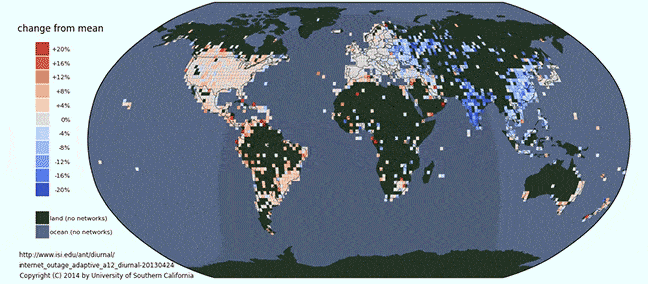There are over 4 billion IP addresses registered all over the globe and this number is constantly growing as developing countries get wired and more people use smartphones and tablets. The internet isn’t the same all over the world (yet) and activity heavily fluctuates from day to night. A new study mapped the world’s internet activity using an extremely simple yet effective method: ping.
John Heidemann, a University of Southern California Viterbi School of Engineering project leader and computer science assistant professor, pinged 3.7 million IP address blocks or nearly a billion unique terminals (computers, routers, phones, etc) every 11 minutes for two months. After making sense of this immense volume of data, the researchers were able to map how internet activity fluctuates all over the world, day or night.
The major insights were that addresses in North America, where routers are heavily used, are active almost around the clock, while those in Eastern Europe, Asia and South America experienced a visible shift between night and day. Of course, the study’s objective goes far beyond just checking when people use the internet most – this has been performed countless times before. The key insights the researchers want to uncover are the internet’s weak links; network hubs that are unresponsive. This sort of data can also be used as a metric for economic developments. As you can see from the map and the video embedded in the post, developing countries have a much smaller range of internet penetration than developed countries in North America or Europe.
“This data helps us establish a baseline for the internet,” says Heidemann, “To understand how it functions, so that we have a better idea of how resilient it is as a whole, and can spot problems quicker.”
Perhaps, what’s most interesting about Heidemann’s map is that it shows just how connected the world is right now. Truly, we should all be very grateful for the internet – with the good and bad things it comes with. As such, we should all also fight to protect freedom of speech and use of the internet.
Heidemann collaborated with USC’s Lin Quan and Yuri Pradkin on the study, which will be presented at the 2014 ACM Internet Measurements Conference on November 5.







